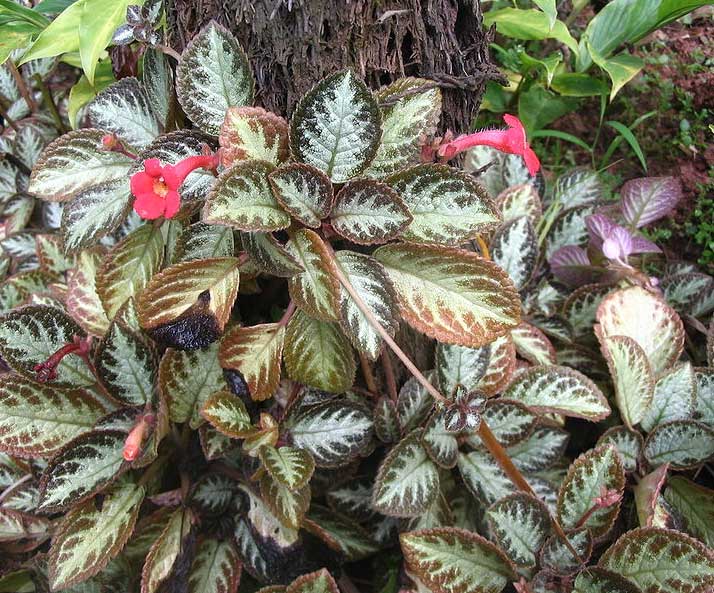
Episcia cupreata
Classification System: APG IV
Superregnum: Eukaryota
Regnum: Plantae
Cladus: Angiosperms
Cladus: Eudicots
Cladus: Core eudicots
Cladus: Asterids
Cladus: Lamiids
Ordo: Lamiales
Familia: Gesneriaceae
Subfamilia: Gesnerioideae
Tribus: Gesnerieae
Subtribus: Columneinae
Genus: Episcia
Species: Episcia cupreata
Name
Episcia cupreata (Hook.) Hanst., 1865
Synonyms
Achimenes cupreata Hook., Bot. Mag. t. 4312 (1847)
Achimenes metallica Van Houtte ex Regel, nom. nud. pro syn.
Achimenes splendens (Linden) Hend.
Cyrtodeira cupreata (Hook.) Hanst., Linnaea, 26: (1853) 207. t. 2, f. 39
Cyrtodeira cupreata var. metallica Regel
Cyrtodeira cupreata var. viridifolia Hook.
Cyrtodeira trianae Hanst., Koch, Allgem. Gartenz. 25: 237 (1857)
Episcia cupreata var. viridifolia (Hook.) G.Nicholson
Episcia splendens (Linden) Hanst., Linnaea, 34: 1865 341 (1866)
Tapina splendens Triana, Belg. Hortic. 7: 198 (1857)
Tapina variegata Linden
Distribution
Native distribution areas:
Continental: Southern America
Regional: Northern South America
Benin
Continental: Southern America
Regional: Brazil
Brazil North
Regional: Northern South America
Colombia, Venezuela
Regional: Central America
Costa Rica, Nicaragua, Panamá
Regional: Western South America
Ecuador
Introduced into:
Bangladesh, Chagos Archipelago, Cuba, Dominican Republic, El Salvador, Honduras, Leeward Is., Mexico Southwest, Puerto Rico, Society Is., Trinidad-Tobago, Venezuelan Antilles, Vietnam
References: Brummitt, R.K. 2001. TDWG – World Geographical Scheme for Recording Plant Distributions, 2nd Edition
References
Primary references
Hanstein, J.L.E.R. v.. 1865. Linnaea; Ein Journal für die Botanik in ihrem ganzen Umfange. Berlin 34:340.
Additional references
Acevedo-Rodríguez, P. & Strong, M.T. (2012). Catalogue of seed plants of the West Indies Smithsonian Contributions to Botany 98: 1-1192.
Govaerts, R.H.A. 2001. World Checklist of Seed Plants Database in ACCESS E-F: 1-50919. [unavailable to the public] Reference page.
Links
Govaerts, R. et al. 2021. Episcia cupreata in Kew Science Plants of the World online. The Board of Trustees of the Royal Botanic Gardens, Kew. Published on the internet. Accessed: 2021 Sep 04. Reference page.
International Plant Names Index. 2021. Episcia cupreata. Published online. Accessed: Sep 04 2021.
Tropicos.org 2021. Episcia cupreata. Missouri Botanical Garden. Published on the internet. Accessed: 2021 Sep 04.
Hassler, M. 2021. Episcia cupreata. World Plants: Synonymic Checklists of the Vascular Plants of the World In: Roskovh, Y., Abucay, L., Orrell, T., Nicolson, D., Bailly, N., Kirk, P., Bourgoin, T., DeWalt, R.E., Decock, W., De Wever, A., Nieukerken, E. van, Zarucchi, J. & Penev, L., eds. 2021. Species 2000 & ITIS Catalogue of Life. Published on the internet. Accessed: 2021 Sep 04. Reference page.
Hassler, M. 2021. World Plants. Synonymic Checklist and Distribution of the World Flora. . Episcia cupreata. Accessed: 04 Sep 2021.
USDA, ARS, Germplasm Resources Information Network. Episcia cupreata in the Germplasm Resources Information Network (GRIN), U.S. Department of Agriculture Agricultural Research Service. Accessed: 07-Oct-06.
Vernacular names
español: Barba de aron, Begonia abisinia
suomi: Hohtokuparilehti
Episcia cupreata is a species of perennial plant in the family Gesneriaceae that is found in Brazil, Colombia, and Venezuela. Its common name is flame violet, although this name may also refer to other species of the genus Episcia.[2] A number of hybrids have been created.
Description
The species has short hairy stems and reddish to green stolons (runners). Leaves are oval shaped with hairy blades that vary from either a deep copper, reddish-green, or only green. Specks of copper and purple are found on leaf underside. Its flower corolla lobes are orange-red with yellow tube. Although the plant does produce seeds, it typically reproduces by stolons.[3]
Ecology
Aphids and mealybugs feed on the plant. It can be subjected to fungal leaf spots, blights on the stem, and rotting roots. The leaves become scorched if they receive too much sunlight, and the plant can die if it receives too much water or too little air.[2]
Hybrids
The hybrid Silver Sheen
The plant was once grown from seeds that were sent to the Royal Botanic Gardens, Kew, from Colombia in 1845. In later years, multiple hybrids with this species were created. While leaf shape varies among hybrids, the flowers always have the same form.[4]
Among the hybrids, 'Acajou' has a broad pattern of leaves that are silver-green, 'Chocolate Soldier' has dark leaves with a wide silver midrib, 'Emerald Green' has a narrow silver midrib with silver vein, 'Frosty' is emerald-green with a wide silver midrib, 'Harlequin' has dark leaves, and 'Silver Sheen' has a silver center with dark margins.[4]
The naturally occurring variety Episcia cupreata var. viridifolia (Hook.) Hanst. was once recognised, but this is now regarded as a junior synonym of the nominate variety, E. c. var. cupreata.[5]
References
The Plant List: A Working List of All Plant Species, retrieved 5 January 2017
"Episcia cupreata". Missouri Botanical Garden. Retrieved June 23, 2019.
"Flame Violet". Flowers of India. Retrieved June 23, 2019.
E. Moore Jr., Harold (1957). African Violets, Gloxinias, and their relatives. The Macmillan Company. pp. 185–187.
Skog, Laurence. "Episcia cupreata var. viridifolia (Hook.) Nichols". Integrated Taxonomic Information System. Retrieved 18 July 2019.
Retrieved from "http://en.wikipedia.org/"
All text is available under the terms of the GNU Free Documentation License

